Patient Deterioration in Nursing Assignment 2022
VerifiedAdded on 2022/09/25
|10
|2711
|22
Assignment
AI Summary
Contribute Materials
Your contribution can guide someone’s learning journey. Share your
documents today.
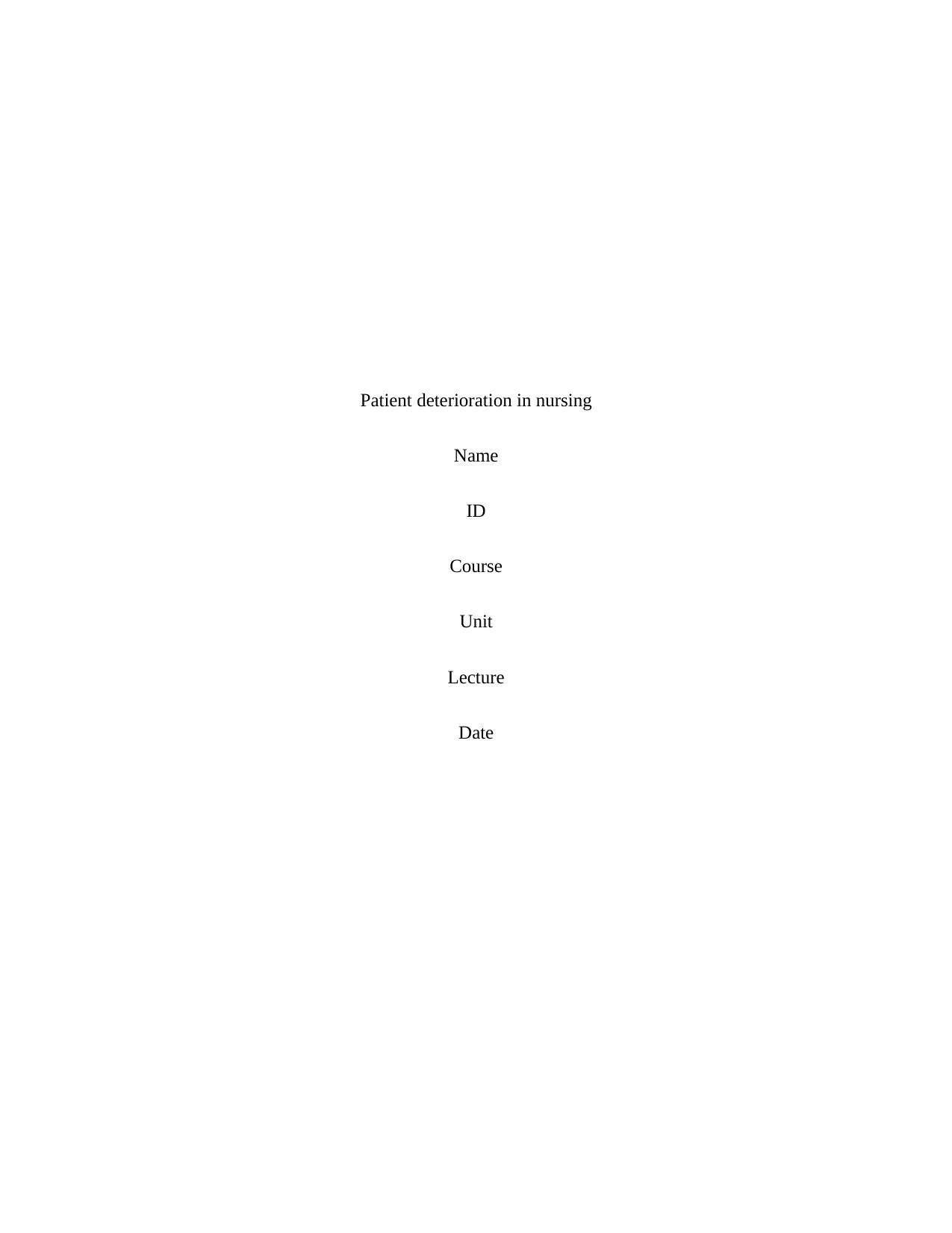
Patient deterioration in nursing
Name
ID
Course
Unit
Lecture
Date
Name
ID
Course
Unit
Lecture
Date
Secure Best Marks with AI Grader
Need help grading? Try our AI Grader for instant feedback on your assignments.
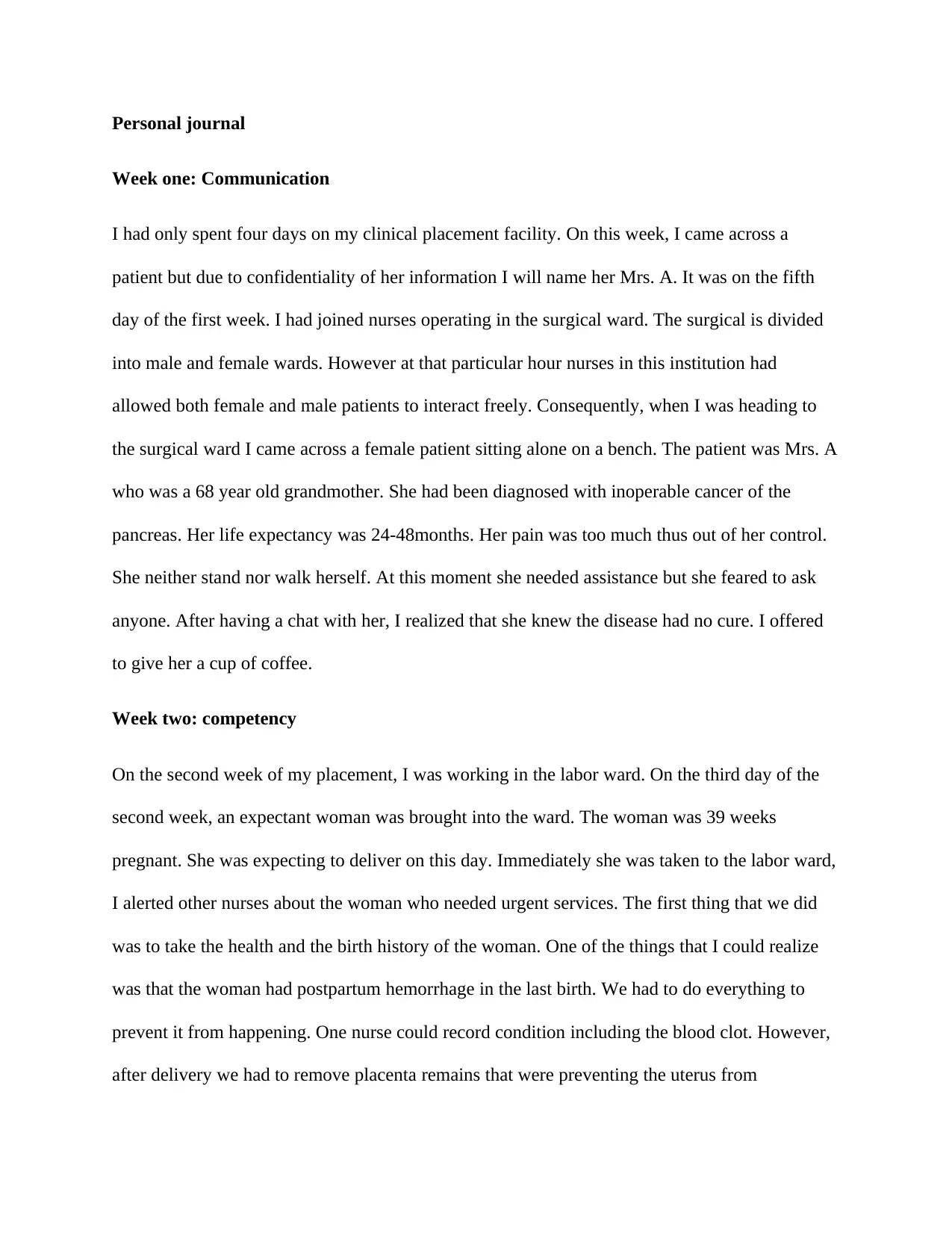
Personal journal
Week one: Communication
I had only spent four days on my clinical placement facility. On this week, I came across a
patient but due to confidentiality of her information I will name her Mrs. A. It was on the fifth
day of the first week. I had joined nurses operating in the surgical ward. The surgical is divided
into male and female wards. However at that particular hour nurses in this institution had
allowed both female and male patients to interact freely. Consequently, when I was heading to
the surgical ward I came across a female patient sitting alone on a bench. The patient was Mrs. A
who was a 68 year old grandmother. She had been diagnosed with inoperable cancer of the
pancreas. Her life expectancy was 24-48months. Her pain was too much thus out of her control.
She neither stand nor walk herself. At this moment she needed assistance but she feared to ask
anyone. After having a chat with her, I realized that she knew the disease had no cure. I offered
to give her a cup of coffee.
Week two: competency
On the second week of my placement, I was working in the labor ward. On the third day of the
second week, an expectant woman was brought into the ward. The woman was 39 weeks
pregnant. She was expecting to deliver on this day. Immediately she was taken to the labor ward,
I alerted other nurses about the woman who needed urgent services. The first thing that we did
was to take the health and the birth history of the woman. One of the things that I could realize
was that the woman had postpartum hemorrhage in the last birth. We had to do everything to
prevent it from happening. One nurse could record condition including the blood clot. However,
after delivery we had to remove placenta remains that were preventing the uterus from
Week one: Communication
I had only spent four days on my clinical placement facility. On this week, I came across a
patient but due to confidentiality of her information I will name her Mrs. A. It was on the fifth
day of the first week. I had joined nurses operating in the surgical ward. The surgical is divided
into male and female wards. However at that particular hour nurses in this institution had
allowed both female and male patients to interact freely. Consequently, when I was heading to
the surgical ward I came across a female patient sitting alone on a bench. The patient was Mrs. A
who was a 68 year old grandmother. She had been diagnosed with inoperable cancer of the
pancreas. Her life expectancy was 24-48months. Her pain was too much thus out of her control.
She neither stand nor walk herself. At this moment she needed assistance but she feared to ask
anyone. After having a chat with her, I realized that she knew the disease had no cure. I offered
to give her a cup of coffee.
Week two: competency
On the second week of my placement, I was working in the labor ward. On the third day of the
second week, an expectant woman was brought into the ward. The woman was 39 weeks
pregnant. She was expecting to deliver on this day. Immediately she was taken to the labor ward,
I alerted other nurses about the woman who needed urgent services. The first thing that we did
was to take the health and the birth history of the woman. One of the things that I could realize
was that the woman had postpartum hemorrhage in the last birth. We had to do everything to
prevent it from happening. One nurse could record condition including the blood clot. However,
after delivery we had to remove placenta remains that were preventing the uterus from
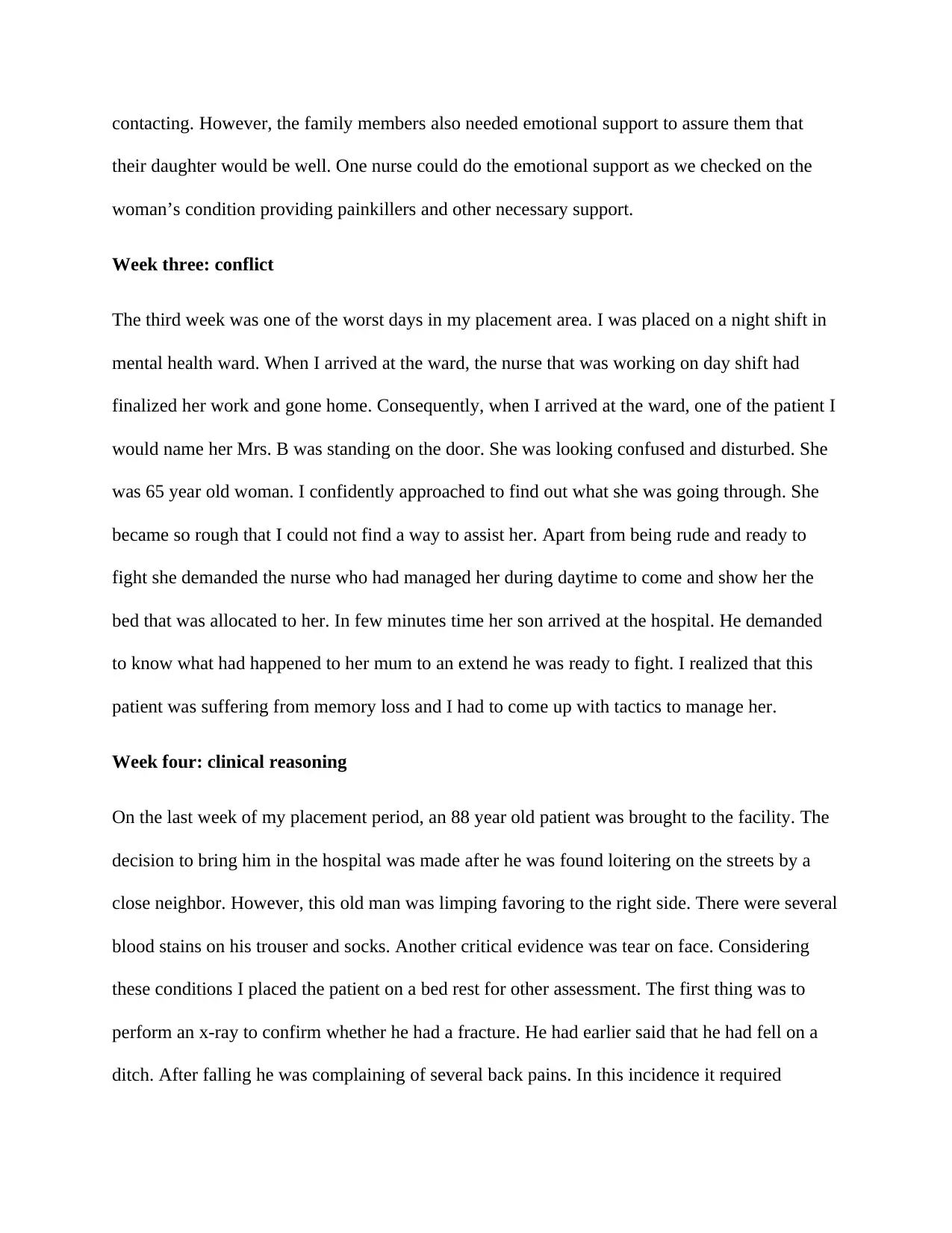
contacting. However, the family members also needed emotional support to assure them that
their daughter would be well. One nurse could do the emotional support as we checked on the
woman’s condition providing painkillers and other necessary support.
Week three: conflict
The third week was one of the worst days in my placement area. I was placed on a night shift in
mental health ward. When I arrived at the ward, the nurse that was working on day shift had
finalized her work and gone home. Consequently, when I arrived at the ward, one of the patient I
would name her Mrs. B was standing on the door. She was looking confused and disturbed. She
was 65 year old woman. I confidently approached to find out what she was going through. She
became so rough that I could not find a way to assist her. Apart from being rude and ready to
fight she demanded the nurse who had managed her during daytime to come and show her the
bed that was allocated to her. In few minutes time her son arrived at the hospital. He demanded
to know what had happened to her mum to an extend he was ready to fight. I realized that this
patient was suffering from memory loss and I had to come up with tactics to manage her.
Week four: clinical reasoning
On the last week of my placement period, an 88 year old patient was brought to the facility. The
decision to bring him in the hospital was made after he was found loitering on the streets by a
close neighbor. However, this old man was limping favoring to the right side. There were several
blood stains on his trouser and socks. Another critical evidence was tear on face. Considering
these conditions I placed the patient on a bed rest for other assessment. The first thing was to
perform an x-ray to confirm whether he had a fracture. He had earlier said that he had fell on a
ditch. After falling he was complaining of several back pains. In this incidence it required
their daughter would be well. One nurse could do the emotional support as we checked on the
woman’s condition providing painkillers and other necessary support.
Week three: conflict
The third week was one of the worst days in my placement area. I was placed on a night shift in
mental health ward. When I arrived at the ward, the nurse that was working on day shift had
finalized her work and gone home. Consequently, when I arrived at the ward, one of the patient I
would name her Mrs. B was standing on the door. She was looking confused and disturbed. She
was 65 year old woman. I confidently approached to find out what she was going through. She
became so rough that I could not find a way to assist her. Apart from being rude and ready to
fight she demanded the nurse who had managed her during daytime to come and show her the
bed that was allocated to her. In few minutes time her son arrived at the hospital. He demanded
to know what had happened to her mum to an extend he was ready to fight. I realized that this
patient was suffering from memory loss and I had to come up with tactics to manage her.
Week four: clinical reasoning
On the last week of my placement period, an 88 year old patient was brought to the facility. The
decision to bring him in the hospital was made after he was found loitering on the streets by a
close neighbor. However, this old man was limping favoring to the right side. There were several
blood stains on his trouser and socks. Another critical evidence was tear on face. Considering
these conditions I placed the patient on a bed rest for other assessment. The first thing was to
perform an x-ray to confirm whether he had a fracture. He had earlier said that he had fell on a
ditch. After falling he was complaining of several back pains. In this incidence it required
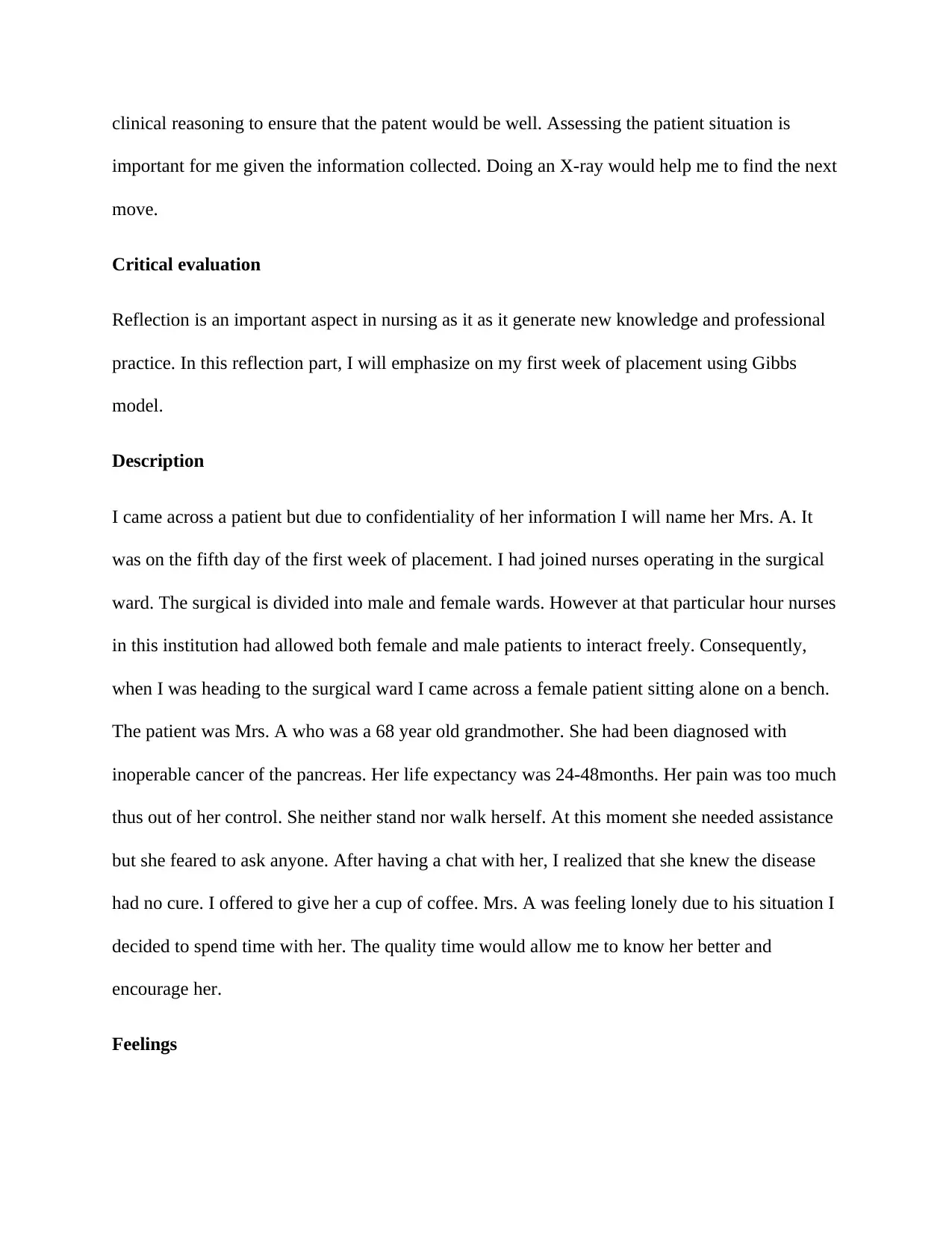
clinical reasoning to ensure that the patent would be well. Assessing the patient situation is
important for me given the information collected. Doing an X-ray would help me to find the next
move.
Critical evaluation
Reflection is an important aspect in nursing as it as it generate new knowledge and professional
practice. In this reflection part, I will emphasize on my first week of placement using Gibbs
model.
Description
I came across a patient but due to confidentiality of her information I will name her Mrs. A. It
was on the fifth day of the first week of placement. I had joined nurses operating in the surgical
ward. The surgical is divided into male and female wards. However at that particular hour nurses
in this institution had allowed both female and male patients to interact freely. Consequently,
when I was heading to the surgical ward I came across a female patient sitting alone on a bench.
The patient was Mrs. A who was a 68 year old grandmother. She had been diagnosed with
inoperable cancer of the pancreas. Her life expectancy was 24-48months. Her pain was too much
thus out of her control. She neither stand nor walk herself. At this moment she needed assistance
but she feared to ask anyone. After having a chat with her, I realized that she knew the disease
had no cure. I offered to give her a cup of coffee. Mrs. A was feeling lonely due to his situation I
decided to spend time with her. The quality time would allow me to know her better and
encourage her.
Feelings
important for me given the information collected. Doing an X-ray would help me to find the next
move.
Critical evaluation
Reflection is an important aspect in nursing as it as it generate new knowledge and professional
practice. In this reflection part, I will emphasize on my first week of placement using Gibbs
model.
Description
I came across a patient but due to confidentiality of her information I will name her Mrs. A. It
was on the fifth day of the first week of placement. I had joined nurses operating in the surgical
ward. The surgical is divided into male and female wards. However at that particular hour nurses
in this institution had allowed both female and male patients to interact freely. Consequently,
when I was heading to the surgical ward I came across a female patient sitting alone on a bench.
The patient was Mrs. A who was a 68 year old grandmother. She had been diagnosed with
inoperable cancer of the pancreas. Her life expectancy was 24-48months. Her pain was too much
thus out of her control. She neither stand nor walk herself. At this moment she needed assistance
but she feared to ask anyone. After having a chat with her, I realized that she knew the disease
had no cure. I offered to give her a cup of coffee. Mrs. A was feeling lonely due to his situation I
decided to spend time with her. The quality time would allow me to know her better and
encourage her.
Feelings
Secure Best Marks with AI Grader
Need help grading? Try our AI Grader for instant feedback on your assignments.
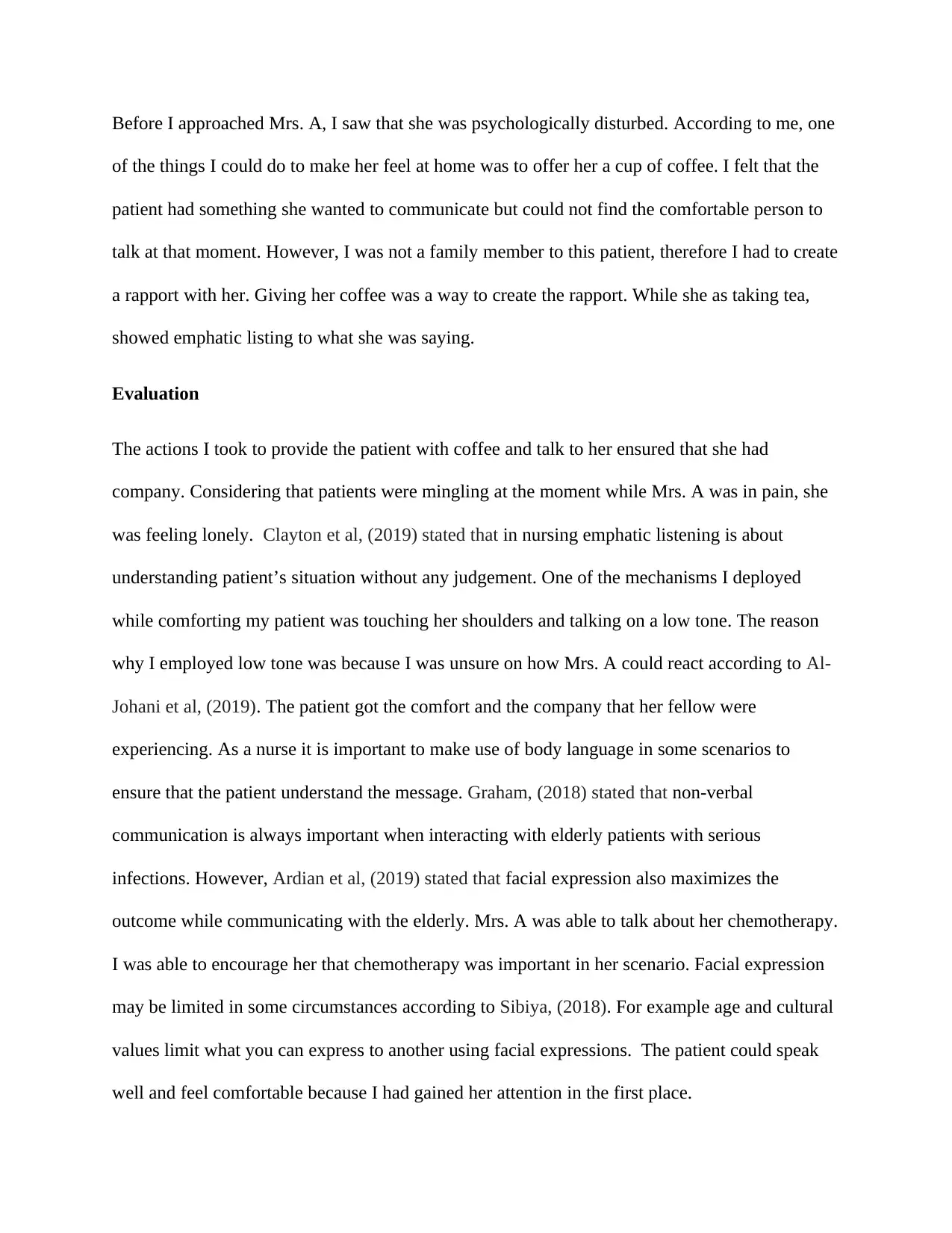
Before I approached Mrs. A, I saw that she was psychologically disturbed. According to me, one
of the things I could do to make her feel at home was to offer her a cup of coffee. I felt that the
patient had something she wanted to communicate but could not find the comfortable person to
talk at that moment. However, I was not a family member to this patient, therefore I had to create
a rapport with her. Giving her coffee was a way to create the rapport. While she as taking tea,
showed emphatic listing to what she was saying.
Evaluation
The actions I took to provide the patient with coffee and talk to her ensured that she had
company. Considering that patients were mingling at the moment while Mrs. A was in pain, she
was feeling lonely. Clayton et al, (2019) stated that in nursing emphatic listening is about
understanding patient’s situation without any judgement. One of the mechanisms I deployed
while comforting my patient was touching her shoulders and talking on a low tone. The reason
why I employed low tone was because I was unsure on how Mrs. A could react according to Al-
Johani et al, (2019). The patient got the comfort and the company that her fellow were
experiencing. As a nurse it is important to make use of body language in some scenarios to
ensure that the patient understand the message. Graham, (2018) stated that non-verbal
communication is always important when interacting with elderly patients with serious
infections. However, Ardian et al, (2019) stated that facial expression also maximizes the
outcome while communicating with the elderly. Mrs. A was able to talk about her chemotherapy.
I was able to encourage her that chemotherapy was important in her scenario. Facial expression
may be limited in some circumstances according to Sibiya, (2018). For example age and cultural
values limit what you can express to another using facial expressions. The patient could speak
well and feel comfortable because I had gained her attention in the first place.
of the things I could do to make her feel at home was to offer her a cup of coffee. I felt that the
patient had something she wanted to communicate but could not find the comfortable person to
talk at that moment. However, I was not a family member to this patient, therefore I had to create
a rapport with her. Giving her coffee was a way to create the rapport. While she as taking tea,
showed emphatic listing to what she was saying.
Evaluation
The actions I took to provide the patient with coffee and talk to her ensured that she had
company. Considering that patients were mingling at the moment while Mrs. A was in pain, she
was feeling lonely. Clayton et al, (2019) stated that in nursing emphatic listening is about
understanding patient’s situation without any judgement. One of the mechanisms I deployed
while comforting my patient was touching her shoulders and talking on a low tone. The reason
why I employed low tone was because I was unsure on how Mrs. A could react according to Al-
Johani et al, (2019). The patient got the comfort and the company that her fellow were
experiencing. As a nurse it is important to make use of body language in some scenarios to
ensure that the patient understand the message. Graham, (2018) stated that non-verbal
communication is always important when interacting with elderly patients with serious
infections. However, Ardian et al, (2019) stated that facial expression also maximizes the
outcome while communicating with the elderly. Mrs. A was able to talk about her chemotherapy.
I was able to encourage her that chemotherapy was important in her scenario. Facial expression
may be limited in some circumstances according to Sibiya, (2018). For example age and cultural
values limit what you can express to another using facial expressions. The patient could speak
well and feel comfortable because I had gained her attention in the first place.
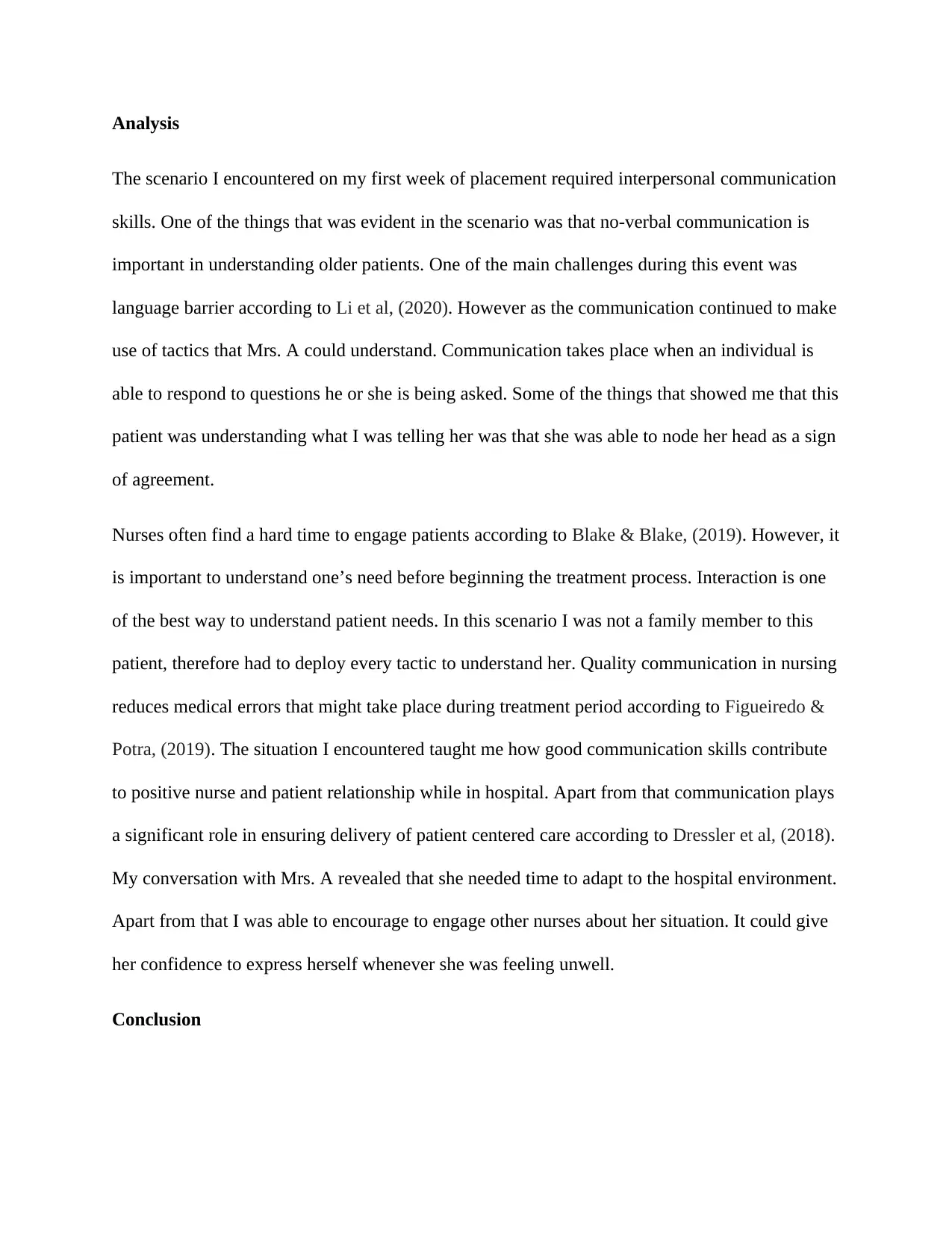
Analysis
The scenario I encountered on my first week of placement required interpersonal communication
skills. One of the things that was evident in the scenario was that no-verbal communication is
important in understanding older patients. One of the main challenges during this event was
language barrier according to Li et al, (2020). However as the communication continued to make
use of tactics that Mrs. A could understand. Communication takes place when an individual is
able to respond to questions he or she is being asked. Some of the things that showed me that this
patient was understanding what I was telling her was that she was able to node her head as a sign
of agreement.
Nurses often find a hard time to engage patients according to Blake & Blake, (2019). However, it
is important to understand one’s need before beginning the treatment process. Interaction is one
of the best way to understand patient needs. In this scenario I was not a family member to this
patient, therefore had to deploy every tactic to understand her. Quality communication in nursing
reduces medical errors that might take place during treatment period according to Figueiredo &
Potra, (2019). The situation I encountered taught me how good communication skills contribute
to positive nurse and patient relationship while in hospital. Apart from that communication plays
a significant role in ensuring delivery of patient centered care according to Dressler et al, (2018).
My conversation with Mrs. A revealed that she needed time to adapt to the hospital environment.
Apart from that I was able to encourage to engage other nurses about her situation. It could give
her confidence to express herself whenever she was feeling unwell.
Conclusion
The scenario I encountered on my first week of placement required interpersonal communication
skills. One of the things that was evident in the scenario was that no-verbal communication is
important in understanding older patients. One of the main challenges during this event was
language barrier according to Li et al, (2020). However as the communication continued to make
use of tactics that Mrs. A could understand. Communication takes place when an individual is
able to respond to questions he or she is being asked. Some of the things that showed me that this
patient was understanding what I was telling her was that she was able to node her head as a sign
of agreement.
Nurses often find a hard time to engage patients according to Blake & Blake, (2019). However, it
is important to understand one’s need before beginning the treatment process. Interaction is one
of the best way to understand patient needs. In this scenario I was not a family member to this
patient, therefore had to deploy every tactic to understand her. Quality communication in nursing
reduces medical errors that might take place during treatment period according to Figueiredo &
Potra, (2019). The situation I encountered taught me how good communication skills contribute
to positive nurse and patient relationship while in hospital. Apart from that communication plays
a significant role in ensuring delivery of patient centered care according to Dressler et al, (2018).
My conversation with Mrs. A revealed that she needed time to adapt to the hospital environment.
Apart from that I was able to encourage to engage other nurses about her situation. It could give
her confidence to express herself whenever she was feeling unwell.
Conclusion
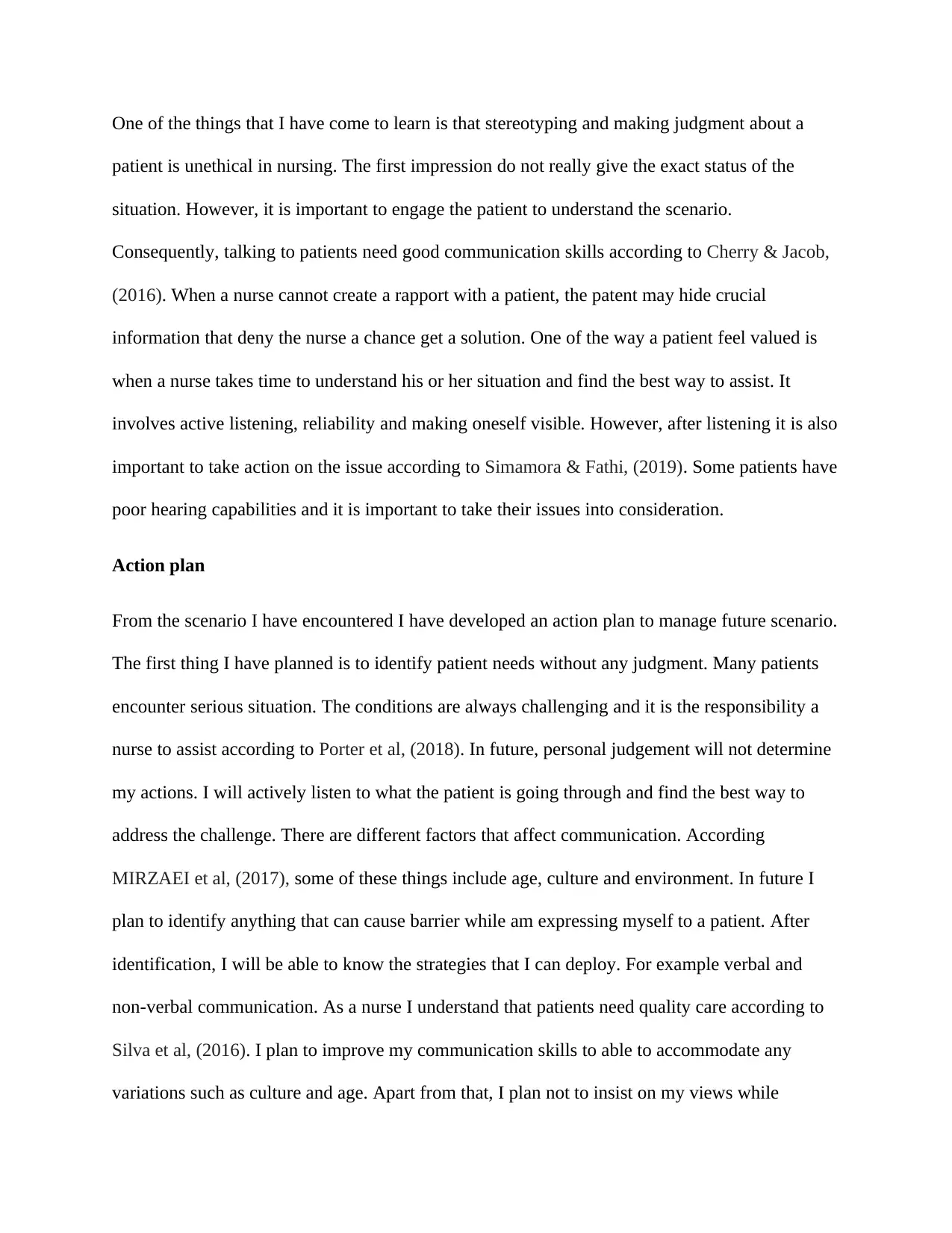
One of the things that I have come to learn is that stereotyping and making judgment about a
patient is unethical in nursing. The first impression do not really give the exact status of the
situation. However, it is important to engage the patient to understand the scenario.
Consequently, talking to patients need good communication skills according to Cherry & Jacob,
(2016). When a nurse cannot create a rapport with a patient, the patent may hide crucial
information that deny the nurse a chance get a solution. One of the way a patient feel valued is
when a nurse takes time to understand his or her situation and find the best way to assist. It
involves active listening, reliability and making oneself visible. However, after listening it is also
important to take action on the issue according to Simamora & Fathi, (2019). Some patients have
poor hearing capabilities and it is important to take their issues into consideration.
Action plan
From the scenario I have encountered I have developed an action plan to manage future scenario.
The first thing I have planned is to identify patient needs without any judgment. Many patients
encounter serious situation. The conditions are always challenging and it is the responsibility a
nurse to assist according to Porter et al, (2018). In future, personal judgement will not determine
my actions. I will actively listen to what the patient is going through and find the best way to
address the challenge. There are different factors that affect communication. According
MIRZAEI et al, (2017), some of these things include age, culture and environment. In future I
plan to identify anything that can cause barrier while am expressing myself to a patient. After
identification, I will be able to know the strategies that I can deploy. For example verbal and
non-verbal communication. As a nurse I understand that patients need quality care according to
Silva et al, (2016). I plan to improve my communication skills to able to accommodate any
variations such as culture and age. Apart from that, I plan not to insist on my views while
patient is unethical in nursing. The first impression do not really give the exact status of the
situation. However, it is important to engage the patient to understand the scenario.
Consequently, talking to patients need good communication skills according to Cherry & Jacob,
(2016). When a nurse cannot create a rapport with a patient, the patent may hide crucial
information that deny the nurse a chance get a solution. One of the way a patient feel valued is
when a nurse takes time to understand his or her situation and find the best way to assist. It
involves active listening, reliability and making oneself visible. However, after listening it is also
important to take action on the issue according to Simamora & Fathi, (2019). Some patients have
poor hearing capabilities and it is important to take their issues into consideration.
Action plan
From the scenario I have encountered I have developed an action plan to manage future scenario.
The first thing I have planned is to identify patient needs without any judgment. Many patients
encounter serious situation. The conditions are always challenging and it is the responsibility a
nurse to assist according to Porter et al, (2018). In future, personal judgement will not determine
my actions. I will actively listen to what the patient is going through and find the best way to
address the challenge. There are different factors that affect communication. According
MIRZAEI et al, (2017), some of these things include age, culture and environment. In future I
plan to identify anything that can cause barrier while am expressing myself to a patient. After
identification, I will be able to know the strategies that I can deploy. For example verbal and
non-verbal communication. As a nurse I understand that patients need quality care according to
Silva et al, (2016). I plan to improve my communication skills to able to accommodate any
variations such as culture and age. Apart from that, I plan not to insist on my views while
Paraphrase This Document
Need a fresh take? Get an instant paraphrase of this document with our AI Paraphraser
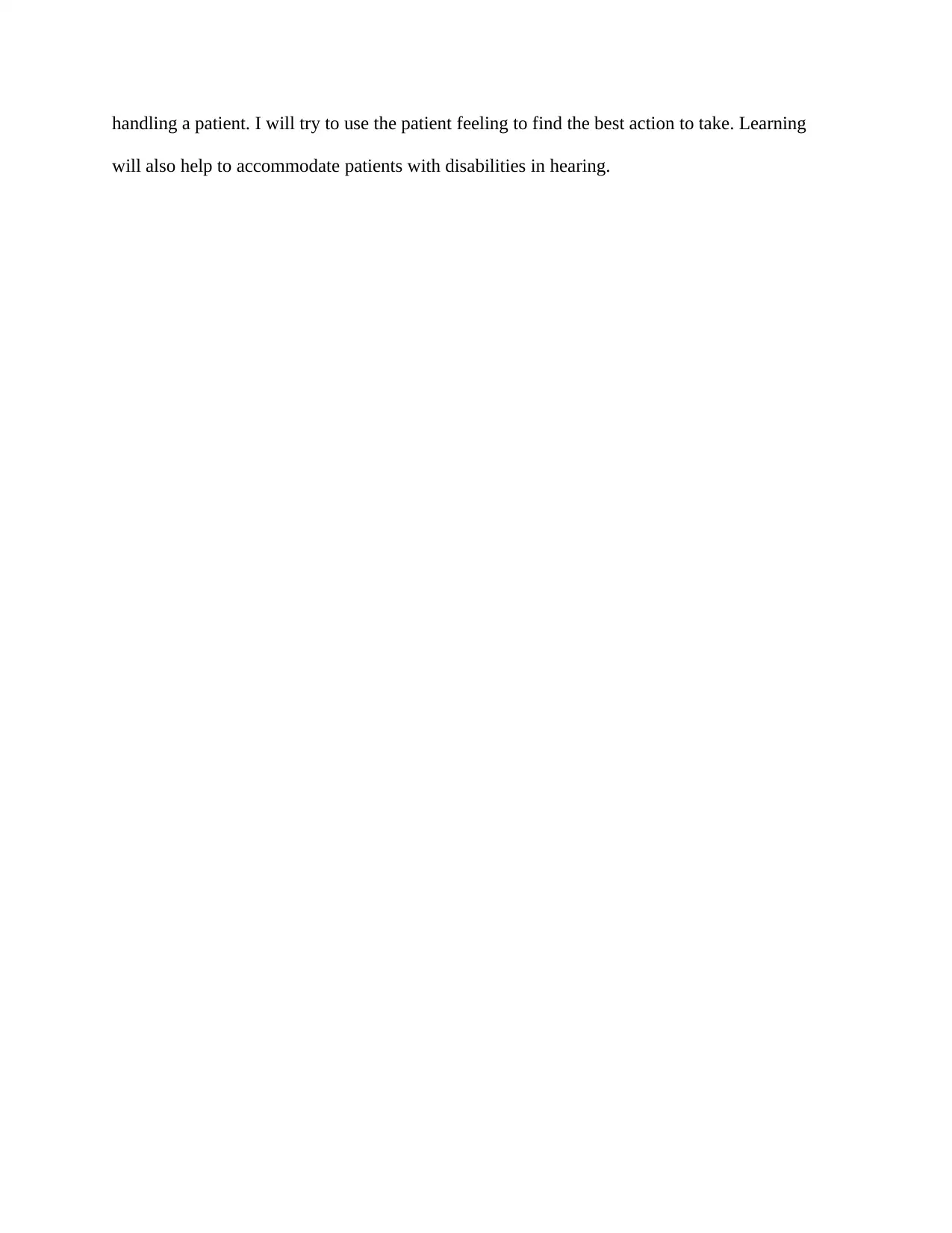
handling a patient. I will try to use the patient feeling to find the best action to take. Learning
will also help to accommodate patients with disabilities in hearing.
will also help to accommodate patients with disabilities in hearing.
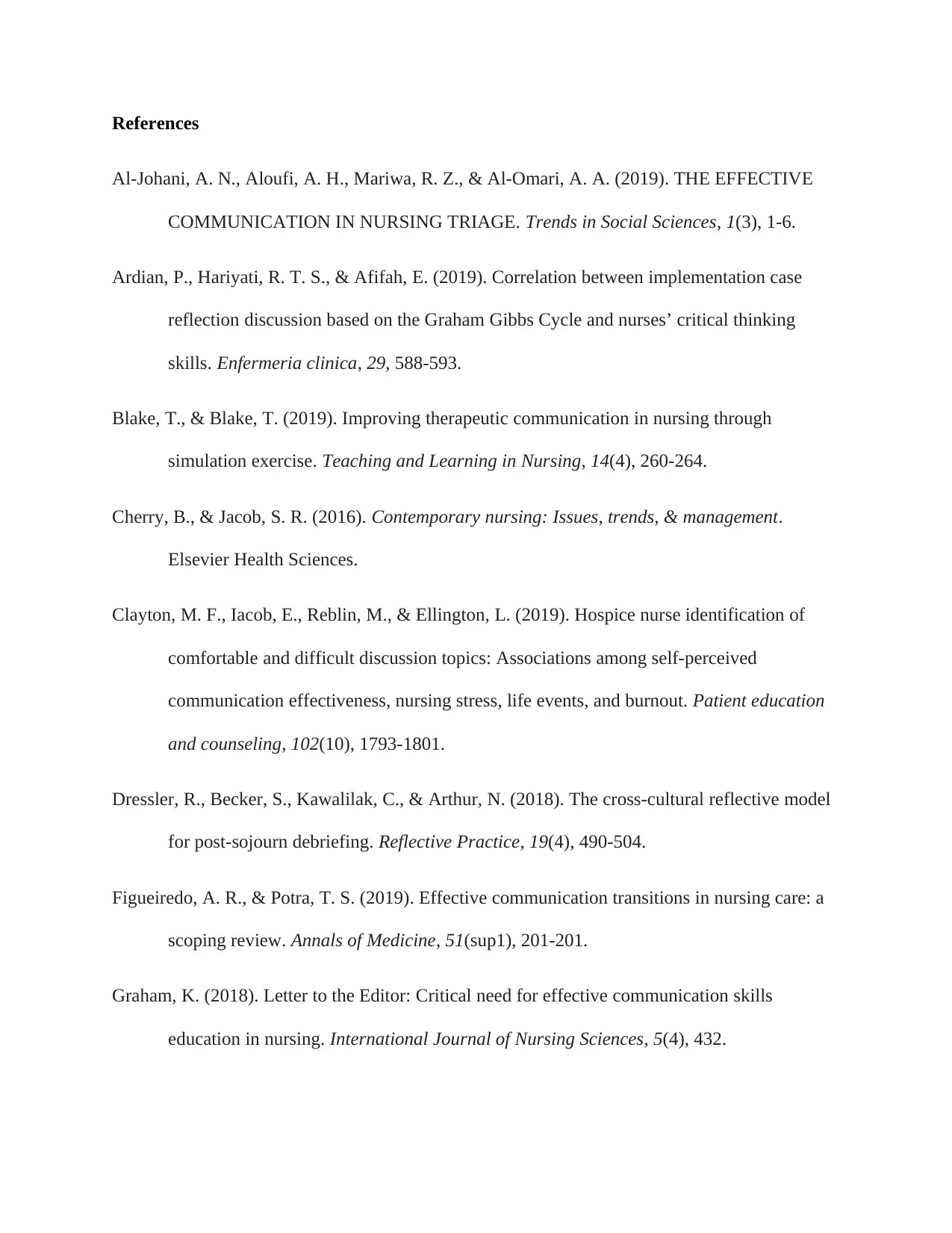
References
Al-Johani, A. N., Aloufi, A. H., Mariwa, R. Z., & Al-Omari, A. A. (2019). THE EFFECTIVE
COMMUNICATION IN NURSING TRIAGE. Trends in Social Sciences, 1(3), 1-6.
Ardian, P., Hariyati, R. T. S., & Afifah, E. (2019). Correlation between implementation case
reflection discussion based on the Graham Gibbs Cycle and nurses’ critical thinking
skills. Enfermeria clinica, 29, 588-593.
Blake, T., & Blake, T. (2019). Improving therapeutic communication in nursing through
simulation exercise. Teaching and Learning in Nursing, 14(4), 260-264.
Cherry, B., & Jacob, S. R. (2016). Contemporary nursing: Issues, trends, & management.
Elsevier Health Sciences.
Clayton, M. F., Iacob, E., Reblin, M., & Ellington, L. (2019). Hospice nurse identification of
comfortable and difficult discussion topics: Associations among self-perceived
communication effectiveness, nursing stress, life events, and burnout. Patient education
and counseling, 102(10), 1793-1801.
Dressler, R., Becker, S., Kawalilak, C., & Arthur, N. (2018). The cross-cultural reflective model
for post-sojourn debriefing. Reflective Practice, 19(4), 490-504.
Figueiredo, A. R., & Potra, T. S. (2019). Effective communication transitions in nursing care: a
scoping review. Annals of Medicine, 51(sup1), 201-201.
Graham, K. (2018). Letter to the Editor: Critical need for effective communication skills
education in nursing. International Journal of Nursing Sciences, 5(4), 432.
Al-Johani, A. N., Aloufi, A. H., Mariwa, R. Z., & Al-Omari, A. A. (2019). THE EFFECTIVE
COMMUNICATION IN NURSING TRIAGE. Trends in Social Sciences, 1(3), 1-6.
Ardian, P., Hariyati, R. T. S., & Afifah, E. (2019). Correlation between implementation case
reflection discussion based on the Graham Gibbs Cycle and nurses’ critical thinking
skills. Enfermeria clinica, 29, 588-593.
Blake, T., & Blake, T. (2019). Improving therapeutic communication in nursing through
simulation exercise. Teaching and Learning in Nursing, 14(4), 260-264.
Cherry, B., & Jacob, S. R. (2016). Contemporary nursing: Issues, trends, & management.
Elsevier Health Sciences.
Clayton, M. F., Iacob, E., Reblin, M., & Ellington, L. (2019). Hospice nurse identification of
comfortable and difficult discussion topics: Associations among self-perceived
communication effectiveness, nursing stress, life events, and burnout. Patient education
and counseling, 102(10), 1793-1801.
Dressler, R., Becker, S., Kawalilak, C., & Arthur, N. (2018). The cross-cultural reflective model
for post-sojourn debriefing. Reflective Practice, 19(4), 490-504.
Figueiredo, A. R., & Potra, T. S. (2019). Effective communication transitions in nursing care: a
scoping review. Annals of Medicine, 51(sup1), 201-201.
Graham, K. (2018). Letter to the Editor: Critical need for effective communication skills
education in nursing. International Journal of Nursing Sciences, 5(4), 432.
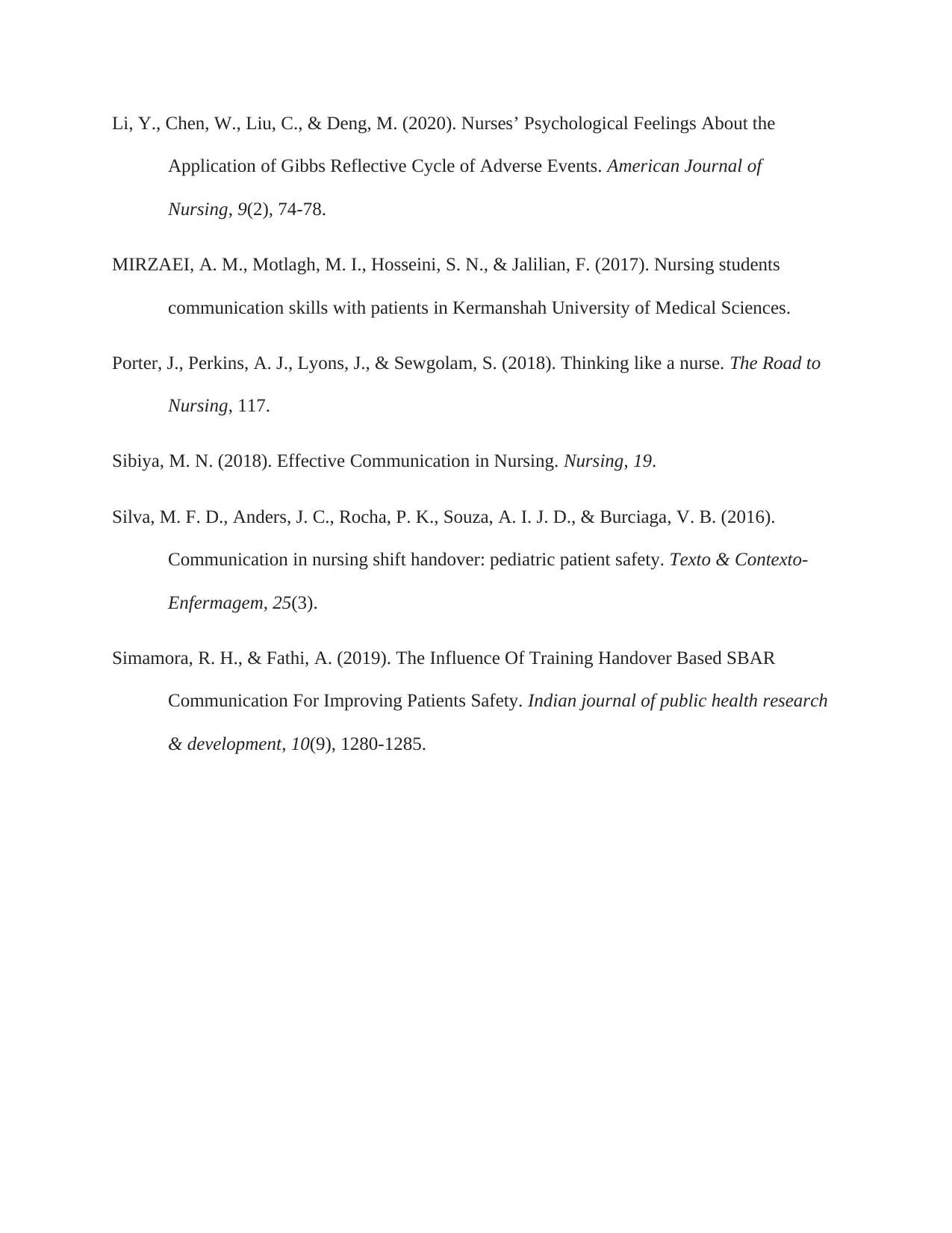
Li, Y., Chen, W., Liu, C., & Deng, M. (2020). Nurses’ Psychological Feelings About the
Application of Gibbs Reflective Cycle of Adverse Events. American Journal of
Nursing, 9(2), 74-78.
MIRZAEI, A. M., Motlagh, M. I., Hosseini, S. N., & Jalilian, F. (2017). Nursing students
communication skills with patients in Kermanshah University of Medical Sciences.
Porter, J., Perkins, A. J., Lyons, J., & Sewgolam, S. (2018). Thinking like a nurse. The Road to
Nursing, 117.
Sibiya, M. N. (2018). Effective Communication in Nursing. Nursing, 19.
Silva, M. F. D., Anders, J. C., Rocha, P. K., Souza, A. I. J. D., & Burciaga, V. B. (2016).
Communication in nursing shift handover: pediatric patient safety. Texto & Contexto-
Enfermagem, 25(3).
Simamora, R. H., & Fathi, A. (2019). The Influence Of Training Handover Based SBAR
Communication For Improving Patients Safety. Indian journal of public health research
& development, 10(9), 1280-1285.
Application of Gibbs Reflective Cycle of Adverse Events. American Journal of
Nursing, 9(2), 74-78.
MIRZAEI, A. M., Motlagh, M. I., Hosseini, S. N., & Jalilian, F. (2017). Nursing students
communication skills with patients in Kermanshah University of Medical Sciences.
Porter, J., Perkins, A. J., Lyons, J., & Sewgolam, S. (2018). Thinking like a nurse. The Road to
Nursing, 117.
Sibiya, M. N. (2018). Effective Communication in Nursing. Nursing, 19.
Silva, M. F. D., Anders, J. C., Rocha, P. K., Souza, A. I. J. D., & Burciaga, V. B. (2016).
Communication in nursing shift handover: pediatric patient safety. Texto & Contexto-
Enfermagem, 25(3).
Simamora, R. H., & Fathi, A. (2019). The Influence Of Training Handover Based SBAR
Communication For Improving Patients Safety. Indian journal of public health research
& development, 10(9), 1280-1285.
1 out of 10
Related Documents
Your All-in-One AI-Powered Toolkit for Academic Success.
+13062052269
info@desklib.com
Available 24*7 on WhatsApp / Email
![[object Object]](/_next/static/media/star-bottom.7253800d.svg)
Unlock your academic potential
© 2024 | Zucol Services PVT LTD | All rights reserved.





